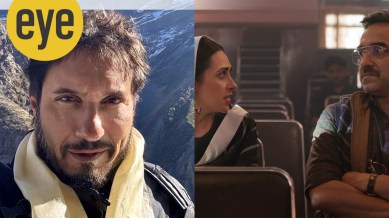Homi Adajania on Murder Mubarak: ‘At best, life is a satire’
Director Homi Adajania on his latest film Murder Mubarak, a mystery set at an elite country club and how he infuses comedy into tragic scenes.

Adapted from Anuja Chauhan’s novel, Club You to Death (HarperCollins, 2021), Homi Adajania’s latest, Murder Mubarak, releases this Friday on Netflix. On the sidelines of a set visit, we spoke to the director on his collaboration with the ensemble cast that includes Pankaj Tripathi, Vijay Varma, Dimple Kapadia and Janhvi Kapoor, and how he experimented with the genre via unique soundscapes. Excerpts:
Did you want your next project to be a murder mystery, or were you interested in Anuja Chauhan’s work?
Neither. With due respect to her work, I wasn’t aware of it. I was told the story of Murder Mubarak and it appealed to me. It was very unique because of the backdrop in an elite Delhi club. It’s a convoluted murder mystery and the credit goes to her for that. My writers adapted it into a juicy script.
Were you involved in the writing?
Credit goes to the writers, Gazal Dhaliwal and Suprotim Sengupta, but I definitely put certain Homi-isms into it, be it certain character traits or arcs or things within scenes. That evolves once you’re on the set and stuff starts breathing into it.
Tell us about directing this ensemble.
With Pankaj Tripathi, it’s been fabulous. Most of us live life and give importance to the memories we create, to things that you can’t really put a value to — he’s one of those things. I’m happy he’s become part of my journey. I’m going to get out of this (movie) being a better person than who I was when I jumped in… The others are an eclectic bunch. It’s a great honour when actors trust you 300 per cent and say, take me wherever, I’m not going to question you.
To depict this country club, you literally had to shoot at multiple hotels to make it seem big and fancy. How did you approach depicting the unimaginable privilege of these characters?
I think it’s beautifully balanced in how you see these characters in their privileged setup — the club — and then you see them outside it. You see their loneliness, their aspirations and their need for validation. That humanises them. When they’re at the club, they’re all putting on a facade. That ensures they’re not a caricature or just over-the-top.
Also Read | Saas Bahu and Flamingo review: Dimple Kapadia-fronted series is heady, a barrel of fun
How does this compare to your previous work?
The last one I did was a mad web series, Saas Bahu Aur Flamingo (2023-), based in a fictitious place called the Borderlands with harsh terrains and gypsies — this is completely removed from that. It’s so refreshing to jump into it. You’re like a kid in a candy store.
There’s always an undercurrent of satire or comedy in your projects. Why?
Because I look at life like that. I think life is a satire, at best. I love looking for humour in the darkest spaces because I feel that’s the way to navigate through life. You spend too much time giving importance to the past rather than just learning from it. We tend to look at the negativity in people rather than the goodness.
For me, it’s very important that I can see humour in everything. And strangely that sort of seeps into the stories I tell. You end up having the darkest characters being humorous or laughing at the most tragic situations in a tongue-in-cheek way. I think they just come very naturally to me, because I live my life like that.
What’s been the most challenging and satisfying part of the shoot?
I think it’s all been satisfying, there’s nothing challenging in shoots. It’s been challenging for the production to balance the dates of such a big ensemble because they’re all busy actors… My actors are an extremely talented bunch of people who come very well-prepped. The joy of seeing all that materialise distracts you from anything that could be a weight. I go home with a big grin on my face.
Tell us about the music of the film.
Sachin-Jigar have done the music. I worked with them on my last project, where I took them out of their comfort zone. With this one, I wanted to go extremely discordant and play around with tunes which unsettle the viewer a bit. I didn’t want to go with the typical suspense, I wanted to flip it on its head and contrast it with the visual.
So you get this strange tempo and melody. I might want very light, beautiful, pretty music playing while a murder is happening, and you (the viewer) wonder what exactly is going on. Let’s see how that pans out.